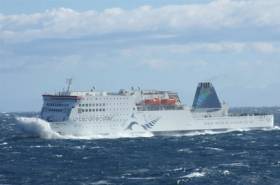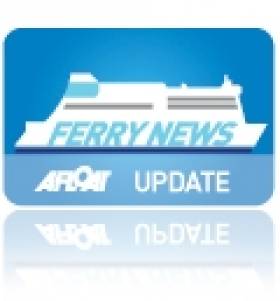Displaying items by tag: Kaitaki
#FerrySale - Irish Continental Group has issued a statement yesterday to confirm the car ferry "Kaitaki" has been delivered to buyers KiwiRail of New Zealand.
ICG agreed consideration of €45.0 million, payable in cash, has been received in full and will be utilised for general corporate purposes.
Afloat adds the 21 year-old vessel has been on charter since 2002 and the majority of that time spent operating on the Cook Strait service. The ferry link connects Wellington on the North Island to Picton on the South Island.
The news follows an announcement by ICG in mid-May of the sale of the former Irish Ferries operated Isle of Innisfree that was custom-built in 1995 to serve a career on the Irish Sea.
Such investment in new tonnage, was badly needed following the acquisition by ICG of the ailing State owned and under-funded B&I Line in 1991.
The British & Irish Steam Packet Co. was established in 1836. Public ownership through the State in 1965 followed the purchase of share capital from Coast Lines Ltd.
#FerrySell - Irish Continental Group (ICG) parent company of Irish Ferries, revealed today it has agreed to sell the €45 million sale of a passenger ferry to a New Zealand company, KiwiRail, as the Irish group reported that its revenues for the first four months for the year grew 4 per cent.
As the Irish Times reports the ferry, Kaitaki built in 1995 and previously operated under names including the Isle of Innisfree and Pride of Cherbourg, has been on charter outside ICG since 2002, most recently to KiwiRail.
The disclosure came in a trading update issued by ICG ahead of its annual general meeting in Dublin. “We consider €45 million for this 21-year-old vessel to be an attractive price,” said analysts at Investec in Dublin in a note to clients, adding that it will leave the group with net cash on the balance sheet.
ICG’s latest trading statement said that consolidated group revenue for the first four months of the year came to €95.1 million, up 4 per cent on the year, while net debt fell to €24.5 million from €37.9 million at the end of 2016.
For the year to May 13th, ICG’s Irish Ferries carried 103,200 cars, a decrease of 0.7 per cent on the same period last year, while roll-on, roll-off (RoRo) freight volumes fell by 1.7 per cent.
For more on the story, click here.
Irish Owned New Zealand Ferry Gets Makeover in Australia
#Interislander – Owned by the Irish Continental Group (ICG), the Interislander flagship Kaitaki set sail for Brisbane, Australia late last month for a 6 week dry dock.
As previously reported the New Zealand route based ship (formerly Irish Ferries Isle of Innisfree) which has been extended on charter from ICG is to have the deck 8 passenger areas completely refurbished.
"Kaitaki passenger spaces have had no refurbishment in the last eight years of the current charter, so the passenger spaces are definitely in need of a facelift," says Interislander General Manager Thomas Davis.
The main scope of the work will include a revamp of the foodcourt area, the bar, the atrium and the toilets on Deck 8, as well as the passenger thoroughfare and shop on deck 7. Approximately $4.5 million has been budgeted for this work.
As Irish Company MJM Marine Ltd, which has had significant experience in ferry and cruise ship refurbishment work, are leading the project, in partnership with Swedish company Figura who specialise in ferry passenger design.
MJM Marine Limited has undertaken refurbishment work on cruise ships like Pacific Pearl, Saga Pearl and Celebrity Infinity, as well as ro-pax ferries like Stena's pair of Superfast ferries on the Irish Sea.
To keep up to date on the progress and see some artists impressions of the refurbishment concepts visit and LIKE our Facebook page.






























































